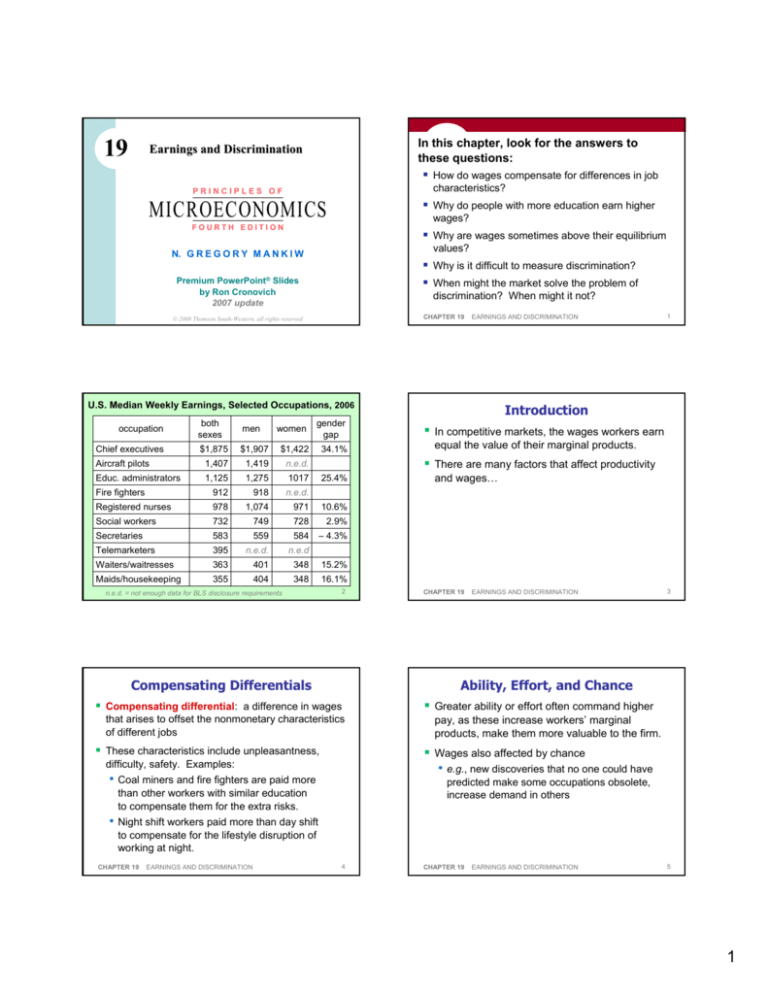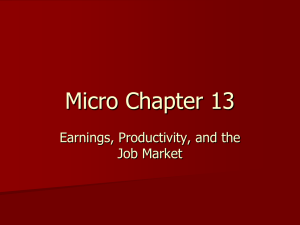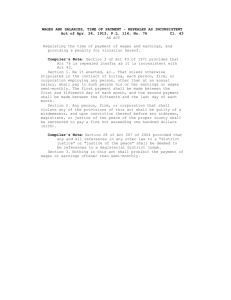
19
In this chapter, look for the answers to
these questions:
How do wages compensate for differences in job
Earnings and Discrimination
characteristics?
PRINCIPLES OF
Why do people with more education earn higher
MICROECONOMICS
wages?
FOURTH EDITION
Why are wages sometimes above their equilibrium
values?
N. G R E G O R Y M A N K I W
Why is it difficult to measure discrimination?
When might the market solve the problem of
Premium PowerPoint® Slides
by Ron Cronovich
2007 update
discrimination? When might it not?
CHAPTER 19
© 2008 Thomson South-Western, all rights reserved
EARNINGS AND DISCRIMINATION
U.S. Median Weekly Earnings, Selected Occupations, 2006
both
sexes
women
gender
gap
men
$1,875
$1,907
$1,422
34.1%
Aircraft pilots
Educ. administrators
1,407
1,419
n.e.d.
1,125
1,275
1017
Fire fighters
912
918
n.e.d.
Registered nurses
978
1,074
971
Social workers
732
749
728
2.9%
Secretaries
583
559
584
– 4.3%
Telemarketers
395
n.e.d.
n.e.d
Waiters/waitresses
363
401
348
15.2%
Maids/housekeeping
355
404
348
16.1%
occupation
Chief executives
In competitive markets, the wages workers earn
equal the value of their marginal products.
and wages…
10.6%
2
Compensating Differentials
CHAPTER 19
EARNINGS AND DISCRIMINATION
3
Ability, Effort, and Chance
Compensating differential: a difference in wages
that arises to offset the nonmonetary characteristics
of different jobs
These characteristics include unpleasantness,
Greater ability or effort often command higher
pay, as these increase workers’ marginal
products, make them more valuable to the firm.
Wages also affected by chance
• e.g., new discoveries that no one could have
difficulty, safety. Examples:
• Coal miners and fire fighters are paid more
than other workers with similar education
to compensate them for the extra risks.
• Night shift workers paid more than day shift
to compensate for the lifestyle disruption of
working at night.
EARNINGS AND DISCRIMINATION
Introduction
There are many factors that affect productivity
25.4%
n.e.d. = not enough data for BLS disclosure requirements
CHAPTER 19
1
predicted make some occupations obsolete,
increase demand in others
4
CHAPTER 19
EARNINGS AND DISCRIMINATION
5
1
Ability, Effort, and Chance
Case Study: The Benefits of Beauty
Ability, effort, and chance are difficult to measure,
Research by Hamermesh and Biddle:
so it is hard to quantify their effects on wages.
• People deemed more attractive than average
They are probably important, though,
earn 5% more than people of average looks.
since easily measurable characteristics
(education, age, etc.) account for less than half
of the variation in wages in our economy.
CHAPTER 19
EARNINGS AND DISCRIMINATION
• Average-looking people earn 5-10% more
than below-average looking people.
6
Case Study: The Benefits of Beauty
Superstars like Tom Cruise, U2 earn many times
more than average in their fields.
Good looks matter for productivity
The best plumbers or carpenters do not.
Superstars arise in markets that have two
• In jobs where appearance is important,
attractive workers are more valuable to the firm,
command higher pay.
Good looks indirectly related to ability
• People who make an effort to project attractive
appearance may be smarter or more competent
in other ways.
Discrimination
EARNINGS AND DISCRIMINATION
8
Human capital: the accumulation of
CHAPTER 19
9
EARNINGS AND DISCRIMINATION
Educational
attainment
investments in people, such as education and
on-the-job training
Human capital affects productivity, and thus
Less than H.S.
labor demand and wages.
EARNINGS AND DISCRIMINATION
characteristics:
• Every customer in the market wants to enjoy
the good supplied by the best producer.
• The good is produced with a technology that
allows the best producer to supply every
customer at a low cost.
Weekly Earnings of Full-Time Employed
Persons Age 25+ by Education, 2006:Q4
Human Capital
CHAPTER 19
7
EARNINGS AND DISCRIMINATION
The Superstar Phenomenon
Hypotheses:
CHAPTER 19
CHAPTER 19
10
Median weekly
earnings
$ 415
H.S. diploma
597
Some college or
Associate degree
700
Bachelor’s degree
966
Advanced degree
1,217
11
2
The Increasing Value of Skills
The Increasing Value of Skills
Two hypotheses:
The earnings gap between
college-educated and
non-college-educated workers
has widened in recent decades.
1. International trade
Rising exports of goods made with skilled labor,
rising imports of goods made with unskilled labor.
2. Skill-biased technological change
New technologies have increased demand for
skilled workers, reduced demand for unskilled
workers.
Percentage difference in annual
earnings for college graduates
vs. high school diploma
CHAPTER 19
1980
2003
Men
44%
82%
Women
35%
71%
EARNINGS AND DISCRIMINATION
ACTIVE LEARNING
Discussion question
Difficult to determine which hypothesis
better explains the widening earnings gap;
probably both are important.
12
1:
CHAPTER 19
EARNINGS AND DISCRIMINATION
13
The Signaling Theory of Education
Suppose you were offered this choice:
A. You could spend 4 years studying at the world’s
best university, but you would have to keep your
attendance there a secret.
B. You could be awarded an official degree from the
world’s best university, but you couldn’t actually
study there.
Which do you think would enhance your future
earnings more?
An alternative view of education:
Firms use education level to sort between
high-ability and low-ability workers.
The difficulty of earning a college degree
demonstrates to prospective employers that
college graduates are highly capable.
Yet, the education itself has no impact on
productivity or skills.
Policy implication: Increasing general
educational attainment would not affect wages.
14
Reasons for Above-Equilibrium Wages
15
3. Efficiency wages
The minimum wage may exceed the eq’m wage
of the least-skilled and experienced workers
Efficiency wages: above-equilibrium wages
paid by firms to increase worker productivity
Firms may pay higher wages to reduce turnover,
increase worker effort, or attract higher-quality
job applicants.
2. Unions
Union: a worker association that bargains with
employers over wages and working conditions
Unions use their market power to obtain higher
wages; most union workers earn 10-20% more
than similar nonunion workers.
EARNINGS AND DISCRIMINATION
EARNINGS AND DISCRIMINATION
Reasons for Above-Equilibrium Wages
1. Minimum wage laws
CHAPTER 19
CHAPTER 19
16
CHAPTER 19
EARNINGS AND DISCRIMINATION
17
3
A C T I V E L E A R N I N G 2:
Explaining wage differentials
The Economics of Discrimination
In each case, identify which worker would earn more
and explain why.
A. The best physical therapist on the planet or
the best writer on the planet
Discrimination: the offering of different
opportunities to similar individuals who differ
only by race, ethnicity, gender, or other personal
characteristics
B. A trucker that hauls produce or a trucker that hauls
hazardous waste from nuclear power plants
C. A graduate of an Ivy League college or an equally
intelligent & capable graduate of a state university
D. Someone who graduated from a state university
with a 3.7 GPA, or someone who graduated from
the same university with a 2.4 GPA
18
CHAPTER 19
EARNINGS AND DISCRIMINATION
19
Measuring Labor-Market Discrimination
Measuring Labor-Market Discrimination
Median earnings of full-time U.S. workers, 2003:
Differences in human capital among groups:
• white males 75% more likely to have college
degree than black males
• white males 11% more likely to have graduate
degree than white females
• women have less on-the-job experience than men
• public schools in many predominantly black areas
are of lower quality (e.g., funding, class sizes)
• White males earn 24% more than white
females.
• White males earn 22% more than black males.
Taken at face value, these differences look like
evidence that employers discriminate.
But there are many possible explanations for wage
differences besides discrimination; the data above
do not control for differences in other factors that
affect wages.
CHAPTER 19
EARNINGS AND DISCRIMINATION
There may well be discrimination in access to
education, but this problem occurs long before
workers enter the labor force.
20
Measuring Labor-Market Discrimination
21
Discrimination by Employers
for employer discrimination:
•
5000 fake résumés sent in response to
help-wanted ads.
•
Half had names more common among blacks,
like Lakisha Washington or Jamal Jones.
The other half had names common among whites,
like Emily Walsh or Greg Baker.
Otherwise, the résumés were the same.
•
The white names received 50% more calls from
interested employers than the black names.
EARNINGS AND DISCRIMINATION
EARNINGS AND DISCRIMINATION
Competitive markets provide a natural remedy
Recent study by Bertrand and Mullainathan finds
evidence of labor-market discrimination:
CHAPTER 19
CHAPTER 19
The profit motive.
22
CHAPTER 19
EARNINGS AND DISCRIMINATION
23
4
Discrimination by Employers
Discrimination by Consumers
Suppose
some firms
discriminate
against
female
workers.
The
discriminating
will workers
begin
to increases,
lose
money
be
non-discriminating
firms
can hire
females
for and
a lower
Result:
demand
forfirms
female
They
will
hire
fewer
driven
outfor
ofmale
the
market.
wage,
giving
them
afemales,
cost advantage
and economic
profits,
demand
workers
fallsmore
untilmales.
wages
are equalized.
which
entry
of other non-discriminating firms.
Result:attract
a wage
differential.
WF
female workers
WM
profits, but customers prefer being served by
whites.
SM
• Then firms have an incentive to hire white
WM
WF
workers, even if non-whites are willing to work
for lower wages.
WM
WF
DF
DF
CHAPTER 19
discriminatory wage differentials.
• Suppose firms care only about maximizing
male workers
SF
Discrimination by consumers may result in
D
DM M
LF
LM
EARNINGS AND DISCRIMINATION
24
CHAPTER 19
EARNINGS AND DISCRIMINATION
Discrimination by Governments
CONCLUSION
In competitive markets, workers are paid a wage
Some government policies mandate
that equals the value of their marginal products.
discriminatory practices.
• apartheid in South Africa before 1994
• early
25
Many factors affect the value of marginal products
and equilibrium wages.
20th
century U.S. laws requiring
segregation in buses and streetcars
The profit motive can correct discrimination by
Such policies prevent the market from correcting
discriminatory wage differentials.
employers, but not discrimination by customers or
discriminatory policies of governments.
Even without discrimination, the distribution of
income may not be equitable or desirable –
a topic we explore in the following chapter.
CHAPTER 19
EARNINGS AND DISCRIMINATION
26
CHAPTER SUMMARY
Other things equal, wage differences compensate
Workers with more human capital are more
27
and chance.
Wages are sometimes pushed above their
equilibrium levels, due to minimum wage laws,
the market power of labor unions, and efficiency
wages.
productive and command higher wages than
workers with less human capital.
Workers with college degrees may get better job
Some differences in earnings are due to
offers because the degree signals high natural
ability to employers.
EARNINGS AND DISCRIMINATION
EARNINGS AND DISCRIMINATION
CHAPTER SUMMARY
Wages also may differ with natural ability, effort,
workers for job attributes: The harder or less
pleasant a job, the more a worker is compensated.
CHAPTER 19
CHAPTER 19
discrimination on the basis of race or other
characteristics. Measuring the amount of
discrimination is difficult, though.
28
CHAPTER 19
EARNINGS AND DISCRIMINATION
29
5
CHAPTER SUMMARY
The profit motive tends to limit the impact of
employer discrimination on wages.
Discrimination by consumers or governments may
lead to persisting wage differentials.
CHAPTER 19
EARNINGS AND DISCRIMINATION
30
6








